A few months back, when most of us were at the height lockdown and working-life was now dominated by never-ending Zoom calls, you may have seen a video doing the rounds online about a guy who scared the living sh*t out of his friends on a video call. Featured on news sites worldwide, with headlines ranging from Man leaves friends petrified after investigating ‘footsteps’ coming from attic and Guy scares sh*t out of friends after telling them there’s something making noise in attic, the 2-minute video went viral, clocking-up millions of views.
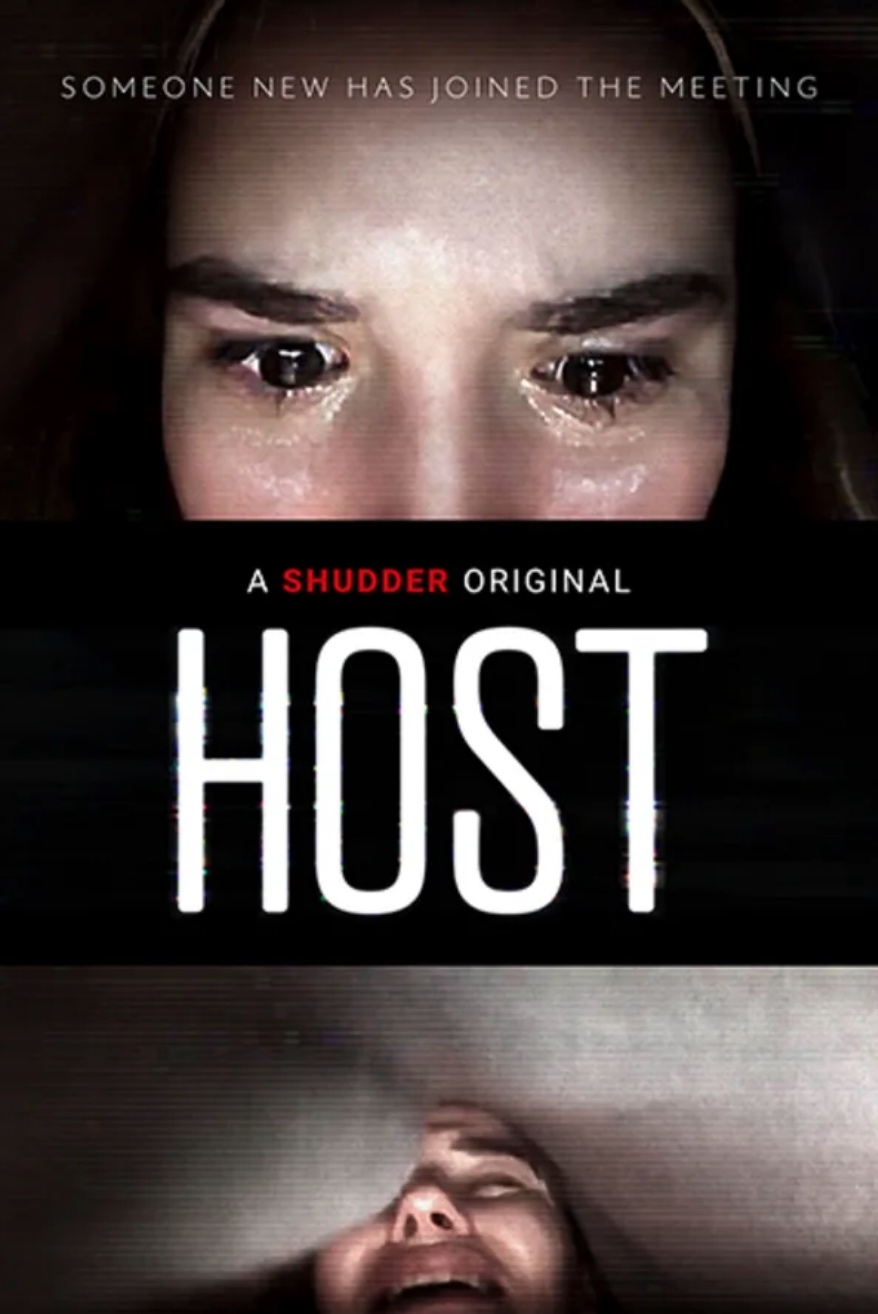 Well, the “guy” in that video was director Rob Savage, a filmmaker we’ve featured on S/W three times – with Healey’s House, Salt & Dawn of the Deaf – and he’s taken that initial idea to freak out his friends and expanding it into the truly unsettling Horror feature Host, for Shudder.
Well, the “guy” in that video was director Rob Savage, a filmmaker we’ve featured on S/W three times – with Healey’s House, Salt & Dawn of the Deaf – and he’s taken that initial idea to freak out his friends and expanding it into the truly unsettling Horror feature Host, for Shudder.
It’s one of the most unusual and exciting short to feature stories we’ve followed on Short of the Week and whilst many of us have struggled to put on trousers for the last few months, Savage has created the ultimate self-isolation film. Speaking to the director over Zoom (a truly nerve-racking experience having watched Host the night before), he provides us with insight into the frantic production of his film and the importance the original viral “prank” played in getting it made.
Thanks for joining us to talk about Host Rob, let’s start with that original Zoom short, where did that idea for that come from?
Well it’s interesting you call it a short. It’s halfway between a short and a stupid prank- video. It actually came from my real life fear that there was a man living in my attic. I’d been living in this flat for about a year and when I moved in, it was the only place I didn’t have access to, as I didn’t have a ladder.
My girlfriend was working in America, so I was here on my own and I just kept hearing these creaking footsteps moving across my ceiling. I’ve got low ceilings in my bedroom, so that’s exactly where the attic is, right by where I sleep. Like the most stupid character in every horror movie, I just brushed it off, didn’t think about it and didn’t do anything about it.
“There’s something here I can use to freak my friends out”
Then one day I came back to my flat and right below the attic door, there was this chocolate bar wrapper and I don’t have any chocolate in the house and I don’t eat chocolate bars. I have no idea where it came from. That really freaked me out. But again, I didn’t do anything about it.
I carried on with my life and then lockdown happened and suddenly I couldn’t leave the house and there might be a serial killer above me. So I decided to check it out and there was nothing there. But I was so scared and I quickly realised, “Oh, there’s something here I can use to freak my friends out”. I was obviously bored after a month of lockdown.
So let me show you, I made this weird contraption out of cardboard and scraps of paper. Can you see that?
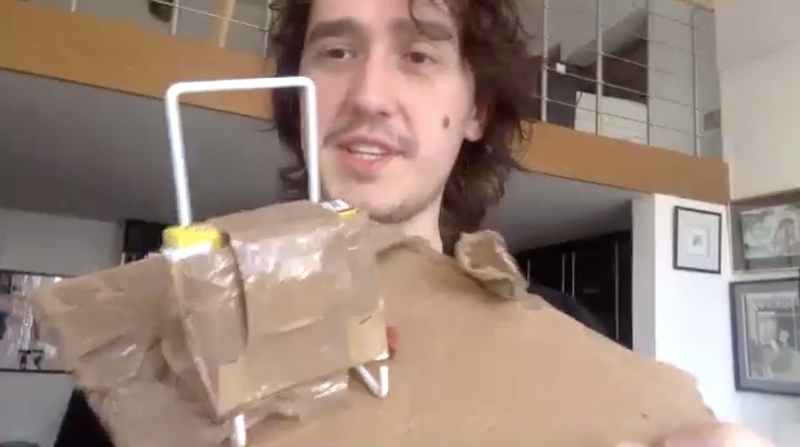
Rob Savage shows off his DIY phone mount that was essential to the success of his viral prank video
Yeah. Yeah. I can see it. Very DIY
I attached this to my laptop. and this is where the phone went. I figured that with a bit of sleight of hand, just putting my hand over my camera, I could actually place my phone so it was facing my laptop screen and nobody would know that they were suddenly watching a recording. So I went up into my attic, did a little bit of fiddly business, and then my friends were suddenly watching a clip out of this film [Rec], which has an amazingly scary attic scene where a zombie jumps out and kills the camera person.
“They didn’t know that I’d set something up, but they recorded it just because it might be fun”
So I spent way more time on that than I care to admit, but I put it together and it worked a treat, it scared the hell out of my friends. They didn’t know that I’d set something up, but they recorded it just because it might be fun.
Then I got into the edit and I had all these different Zoom layouts. Some people were watching on their phone, so they had a quad screen, some of them had the grid view and some of them had speaker view. It was like we had a wide shot, a mid shot and close ups, which meant that I could actually cut an edit together that was quite tense and had all the beats that you’d expect from a cool little horror short. I had fun cutting it. It felt nice to do something creative, even though it was a bit silly. Then it ended up blowing up online and that was really fun too.
I mean it REALLY blew up, the internet went a bit crazy for that video, did that surprise you at all?
No. This is the short filmmaker in me. I feel like when you make something you’ve always got to be a little bit targeted and this was shamefully geared towards maybe becoming viral, if it went well as I thought that this could be something that’s easy to share and easy to digest.
Everyone’s on Zoom now, so everyone gets it, which is why I kept it to two minutes. There was lots of great stuff, people freaking out and thinking I was dead and they were going to call the police and all this kind of stuff, but I kept it super, super concise, so it’s very shareable, just like my short SALT.
We put it online and immediately in the first ten minutes it was getting hundreds of retweets and it was suddenly picking up. It was nice just to have that as a thing that me and all my friends could share during lockdown.
I’ve been hearing strange noises from my attic, so I called a few friends and went to investigate… pic.twitter.com/CxmJAf44ob
— Rob Savage (@DirRobSavage) April 21, 2020
It got picked up by some quite unusual places. I remember having a few different conversations about it with friends, who had didn’t know your shorts or that you were a filmmaker, and it became a thing of “Oh, have you seen this Zoom prank?” That must be quite thrilling?
It was great. It’s kind of ridiculous that this little thing that we knocked together on Zoom has got way more views than anything that I’ve poured my blood, sweat, and tears into.
Then from releasing it online and the film getting all those views, I’m guessing that’s how Shudder discovered it and the conversation around the feature started?
I don’t know if Shudder had actually seen it when we pitched it to them. I think when it blew up we started talking about what the next thing could be and we were talking in terms of, well, is there another prank we could do? But those people you see on the screen are basically all my friends anyway, so I didn’t have any more friends just to prank and nobody trusted me anymore. So we couldn’t do that.
“I was surprised by how easy it was to watch. It wasn’t grating and it wasn’t annoying”
It was great that one half of the internet took it as just a straight prank video and it went on LADbible and all those kinds of sites. But then there was another section of the internet that took it more as a short film. Obviously Short of the Week featured it and it got a Vimeo Staff Pick.
People could kind of see the construction behind it, as well as my friends jumping out of their skin. That kind of engagement made me think that maybe there was something to be done on a larger scale, and with the format I was surprised by how easy it was to watch. It wasn’t grating and it wasn’t annoying. It felt like it could maybe sustain.
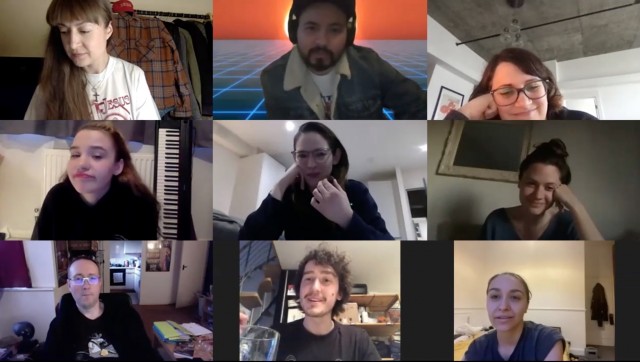
Still from the original Zoom prank
For sure, it’s definitely surprising just how well the format works. Once you’d decided that you wanted to make a larger piece in a similar format, how did you get the feature up and running? You mentioned pitching it to Shudder?
We knew we wanted to get it made before the day-to-day reality changed. We wanted it to be something that we could shoot and release within lockdown, or as close as we could get. The whole thing from the initial idea to delivering it yesterday (Tuesday 28th July 20202) was 12 weeks. So it was really condensed.
We basically went out with the viral video to a bunch of places and the pitch was basically, “give us a bit of money and trust us”, it wasn’t really an idea. Jed Shepherd, who is my producing partner on a lot of these horror things, he had this great idea about a group of friends doing a Zoom seance, rather than playing a board game all night.
“It’ll be scary. You’ve just got to trust us”
There’s this Channel 4 TV movie I did four or five years ago that had a medium character in it. So I’d done a few seances as part of my research for that, and I actually knew a few mediums and I’d been talking to them about what’s mediumship look like in the age of COVID. They said they were doing readings online and that sounded kind of fun. But that was all we had.
So we went to them and said, “group of friends doing a seance over Zoom. It’ll be scary. You’ve just got to trust us and we’ve got to be able to do it our own way.”
Do you think Host would have still got made if you hadn’t had the short to show around?
No. Not at all. All of the big shorts that I’ve made we’re doing as feature films. Salt more specifically than Dawn of the Deaf was done as a little teaser for something bigger that we wanted to make
It’s always helpful to have something to show. Everyone in the industry says, “I can use my imagination, I can picture this”, but nobody really can, it’s just not a skill that people possess. I think they’ve got to have something visual to jump off.
It’s why when you put you put a pitch document together you load it with images. You have character pages, so they can already cast it in their head. The more you can have the movie already made in their mind, the easier it is for them to push the button on it.
So I think for this one, the numbers the short was doing by the time I pitched it around, we had almost four million views, and it’s over that now. Having that was a big vote of confidence. But also, like I said, it’s just the fact that you can watch it and it’s not annoying and you do want to see more. We proved, in a rough way, the format kind of worked.
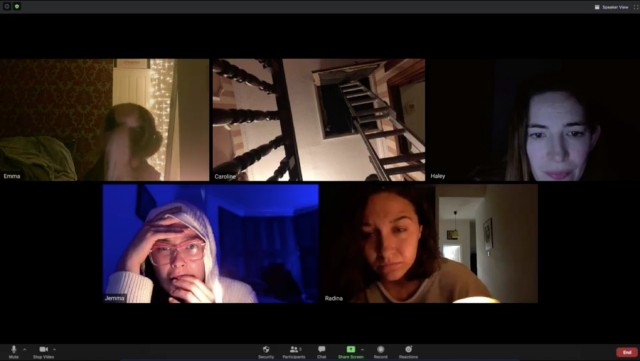
A trip into the attic also features in Savage’s feature length Horror
I can see how the short must have been helpful in getting people to buy into the feature. So at this point, you had the video going viral, Jed had this idea about the seance, but then how did you develop it into something bigger? How did you take it and then turn it into the 60-minute film we see today?
The first thing Jed and I do with any project, short or long, is we get together, we pull a couple of pints and we basically just pitch cool moments at each other. So it really comes set pieces first and we had a few of these when we were pitching to Shudder.
Then the project really started to take shape when we bought on another writer, this great writer called Gemma Hurley, who wrote it with us. She was able to take all of mine and Jed’s excitement and set pieces and all these cool things we wanted to do and she was able to massage that into being a story. Something that had character development
I think it’s very easy to lose that balance. If you don’t invest in your characters, then you can have all the exciting set pieces in the world and nobody’s going to care. Gemma really put it into shape, with her instinct to lean into plot and character and our instinct to lean into scares, I think we ended up with something that’s this nice, happy medium.
I think that’s what I like the most about it. There aren’t that many moments that feel like movie moments because we kept it loose, both because of how we worked on the script and because of the fact that we didn’t have any time to write it. We worked off a document and we never had a full script. It ended up in a space that felt very natural.
Watching a screener of @DirRobSavage's new Zoom-based Horror for @Shudder exactly how it was meant to be viewed.
— _RobMunday (@_RobMunday) July 28, 2020
Huddled over my 12" MacBook in the pitch black, quivering while my girlfriend watches ASMR videos in bed behind me. pic.twitter.com/HAmogehOk9
One of the things we often discuss at Short of the Week is viewing experience. There are films that suffer from an online viewing, but Host isn’t one of them, if anything I’d argue streaming it only adds to the experience. For me, I watched it late last night, huddled over my 12-inch MacBook and there were two moments that really added to the experience and essentially increased just how f*cking tense I was watching it. Firstly, at one point it started buffering, at a really tense moment, and I was certain it was part of the film, something you’d done on purpose. It took me about three minutes to realise. Secondly, I hadn’t turned my notifications off and towards the end, when I was so gripped by the film, a notification pinged on my computer and scared me out of my skin. Were these things you were thinking about when you made Host? As a film made for streaming, did you consider the viewing experience and how to use it to your advantage?
That’s the interesting thing, we had a lot of companies bid on this project and we ended up going with Shudder because they were really on the same page as us about getting this done fast and about giving us the creative control that we needed to figure it out as we went. But also they had an existing audience, that was already built in.
We had some companies who were talking about maybe doing a small theatrical run or doing a drive-in release, but it was all a little bit wishy washy and we needed that certainty of knowing that it was going to land in a way that people could watch if lockdown continued.
“We wanted something that people could watch and have fun with during lockdown”
Things are opening up a little bit over here, but while we were making it, it honestly felt like lockdown was going to be a reality for the rest of the year and we wanted something that people could watch and have fun with during lockdown. It’s not a movie that’s going to change the world. It’s meant to be a fun rollercoaster ride that people see themselves in.
One of the fun things when you’re making horror, is that you’re always trying to find a way to get people to take it home with them, and to still be thinking about the movie when they get back into their house. That’s the really hard thing, because you’ve got this instinct to make things big and cinematic and have these amazing epic locations, but ultimately that puts a bit of a disconnect between your own life and what you’re seeing on screen.
Whereas we wanted it to feel totally grounded, we wanted it to feel exactly like you and me doing this Zoom call right now. We designed the lighting so that it felt totally naturalistic, we didn’t have any movie lights and did it all with the lamps in the house. We did all the automatic settings on the camera, so everything felt grounded in this reality that we’re all living.
I think watching it in that same way that you communicate, it lulls people into the rhythm of the movie. For that reason we kept the Zoom top and bottom bars and the speaker boxes and the names and all that stuff that you associate with Zoom. We kept that on because we knew that people were going to be watching on their laptops. The more that they can almost fool themselves into thinking they’re sitting silently on a Zoom call the better.
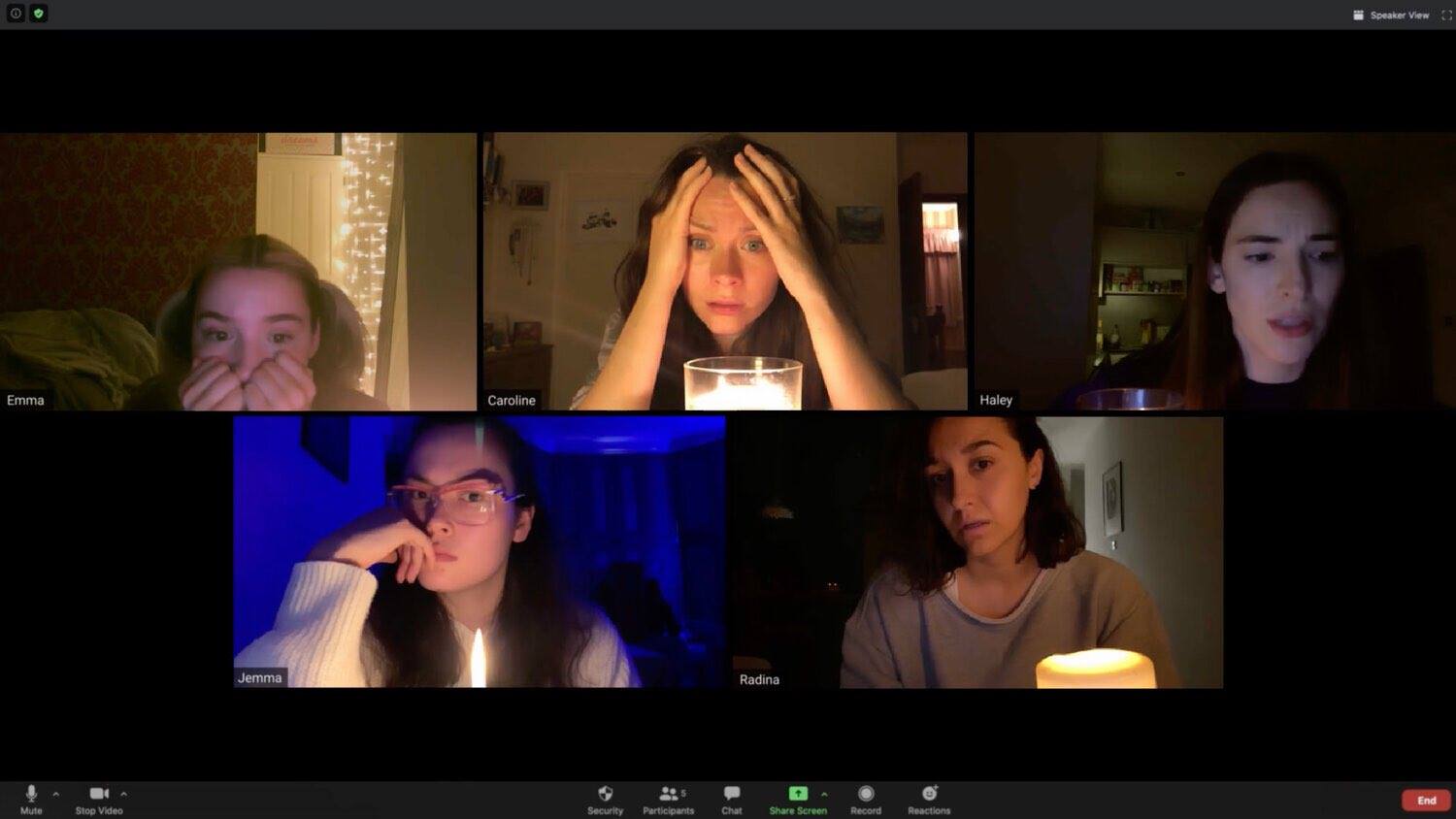
Did you have any other ideas revolving around viewing experience? Knowing that people might be watching on their computers, did you think of how to make it more immersive and feels like it was something they were taking part of it themselves?
It was a weird one to dial up and down. We felt like at the beginning of the movie we’d do a little bit more of the Screenlife thing, like Unfriended, where you have the cursor it feels like your computer screen. However, we wanted to let that drop off a little bit towards the middle, when you really just want to be in there with the characters.
“We were thinking of pretending that all the actors had died in the making of it”
Then we couldn’t resist using the ‘running out of time’ window that comes-up when you’ve got ten minutes left on the Zoom call. I think overall though, we wanted to a bit of a soft touch with that, because it can pull you out of the movie and ultimately it felt like a slightly different language to the rest of the film.
We ran out of time on it, but we were thinking of pretending that all the actors had died in the making of it and we were going to plan to keep them off social media. We had a million other great Zoom scare ideas that we couldn’t quite either quite pull off under the lockdown conditions, or we just wanted to save if we did another one.
Another thing that really interests me about Host is the length. Obviously as a short film platform, it’s something we discuss a lot here at S/W and your film, at 60-minutes long, has an unconventional run-time for a film. Where did the decision to make the film this length come from? Was it decided by Shudder or did you have control over the length?
Contractually, I think it had to be over 30 minutes, as that was what we agreed with Shudder. We went into this not really knowing how long it would turn out, w e had a ten page treatment that we were working off, but we had no idea how long that would stretch. Every day we were coming on Zoom and I was working out the scenes with the actors.
The original concept we pitched to Shudder was that it would be a realtime 40-minute call and we’d do that cut off at the end, exactly as you would when a free meeting ends. The film takes place in movie time, so it’s meant to be a 40-minute meeting, but it’s actually 56 minutes.
The great thing about doing it with Shudder and doing it for a streaming service, is that those times are kind of arbitrary. We were able to just make the movie sit exactly where it needed to sit. The first cut of the movie was an hour and a half, but that’s with all the bagginess still in, all the stuff that felt fun on the day, but just was making the film drag slightly.
I’ve been doing TV for the last five, six years and it’s always such a f*cker when you’ve got to hit those specific timings. The first part has to be 15 minutes, 30 seconds and then ad break and with every ad break you have to build to a crescendo. All this imposed structure that you have to work to means that you’re boxed in a little bit with how you pace things out. It was so nice on this to just say, “Is it working or is it not working?”
This is the problem with longer shorts. I feel like if a short’s over 30-minutes you engage with it as you would a feature. Nobody’s rushing to watch a 40-minute short online, you’re going to watch it at a festival maybe. If it came in at 30 minutes, that would’ve been fine with Shudder and then it would have been a short film that’s on there that people are taking in as though it was a feature. I don’t know really what the distinction is, but I suppose in terms of how they invest in it.
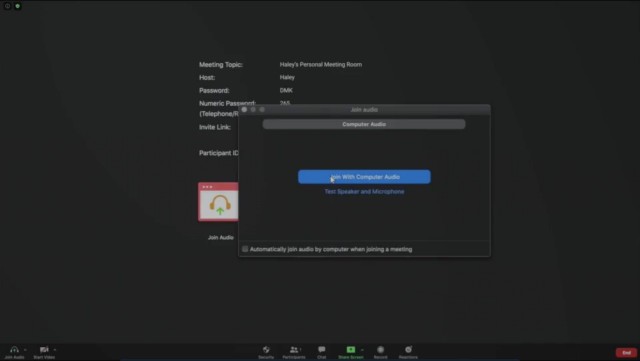
Host begins like your average Zoom call, but for this meeting’s participants things get far worse than any tedious work meeting you’ve experienced online.
Looking back at it now, with hindsight, are you happy with the 60-minute run-time? For me personally, I felt like it flowed so well, I was hooked and tense throughout and though I loved every minute of it, I also don’t think I could have taken much more. I liked the fact it obviously wasn’t padded out just to hit a minimum run-time.
With a film, you’re asking your audience to give up a certain chunk time to watch it and you’ve got to be confident that it’s worth whatever time you’re asking of them. I don’t think this movie was doing anything groundbreaking, it’s taking conventions that we love and putting a slight twist on them.
I think it’d be presumptuous to think that we deserve 90 minutes of somebody’s time if we’ve only got 60 minutes of fun content for them to enjoy. So no, it’s really nice just being able to say, “well that feels about right, let’s cut it off there.”
It must feel quite liberating to have that kind of freedom, not having to make something a certain length just for the sake of it.
Working to time restrictions, there’s always a balance, either you have to cut stuff that you love or you have to put in stuff that you just know is baggy. It’s the thing that keeps me up at night, the idea of knowing that there’s a better film in there, but because of whatever run-time you’ve got to hit, you’ve got to block it out or cut it down. So being able to put something out there that you’re just like, “this is the best of the footage, this is the best length, I’m happy with it”, it’s a really nice feeling.
I bet. Ok, so I know we’re here to talk about the Host today, but it would feel like a missed opportunity to not discuss another project I saw you tweeting about, what can you tell us about this upcoming project you have with Sam Raimi?
That’s was a nice one to announce on the same week as Host. I can’t say much about that, but we’ve been developing that with Sam and Raimi Productions for almost a year now and we’ve got a really great writer, Micah Ranum, on board for that. and he’s just turned in a really great first draft.
“We were like, “how the f*ck has nobody done this before?” We were Googling madly”
It’s in a similar supernatural space to Host, but it’s got a creature/demon element to it that I think I’ve never seen before in a movie. It’s one of those ideas that when me and Jed came up with it and we were like, “how the f*ck has nobody done this before?” We were Googling madly. We honestly live in fear every day that somebody else is going to come up with it and make it. It was really, really good that Sam got behind it and saw the potential in it.
When I was a kid I hid a VHS copy of Evil Dead 2 under my bed and watched it over and over until the tape turned to fuzz. Now me and @Jedshepherd are making a film with our hero Sam Raimi. Deep breath. https://t.co/ABB0BCJnCT
— Rob Savage (@DirRobSavage) July 9, 2020
How exciting is it for you as a big horror fan to be working with Sam Raimi?
Yeah, Sam Raimi! Honestly, since I was about 12 years old, he has been my hero. Every time I jump on the phone with him or when I’m in LA and I sit with him, it feels like I’m in some strange alternate reality. But he’s great, he’s very, and it sounds weird to say, but he’s very Sam Raimi. When you’re throwing around ideas, he’ll pitch something for the movie and it’s such a Sam Raimi idea. It’s so exciting to have been obsessively watching Evil Dead II as a teenager and now be sitting across the table from him.
Ok, final question, then I’ll let you go back to thinking of new ways to freak your friends out, With all these projects in mind – you’ve got Hosts coming out, the new project with Sam Raimi and you mentioned Dawn of the Deaf and SALT features, they’re still kind of in flux are they?
Yeah, We’re doing SALT with Chernin Entertainment, who did the recent Planet of the Apes trilogy and we’re doing … I’m not sure what I can say about Dawn of the Deaf, but we’ve got a great company and producer on board with that. So hoping to have announcements on both of those soon.
So, with all of these projects in mind, how important has your short film work been in getting those moving and picked up? I know as someone who works for a short film platform, that’s a bit of a loaded question, so if you don’t answer correctly, I’ll just cut it! But I think our audience are always interested in the value of short film when it comes to career progression.
The short films that I’ve made have done more for me than anything else.
There’s the quote for the homepage then
Yeah, I think specifically with Dawn of the Deaf and SALT, being able to have two short films that clearly define who I am as a filmmaker and what I want to do, there’s nothing more valuable than that. You can talk all you want, but people are never going to see the same things you have in your head unless you’ve got something to show them.
“Make a short film that crystallises who you are as a filmmaker”
The thing I think every filmmaker should consider, and I say this whenever I go and talk at universities, is that you don’t need to make 100 short films, all in different genres. Just figure out who you are as a filmmaker and what you want to do. If you’ve got a feature idea, what does that look like? Then make a short film that crystallises who you are as a filmmaker.
It saves so much time. Host wouldn’t exist without it and the Raimi project wouldn’t exist without the short films I’ve made, they’ve been essential.
Perfect answer. So in terms of watching Host, people just need to sign up for Shudder to see it?
Yeah, you need to sign up for Shudder. Shudder is only in Canada, America and the UK at the moment, but then Shudder is going to be selling it worldwide as well. So later, down the line, they’ll be other opportunities to see it and we’re going to do a much wider release for it in those territories.
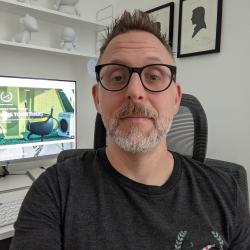 Rob Munday
Rob Munday